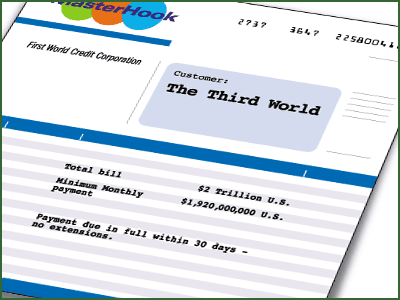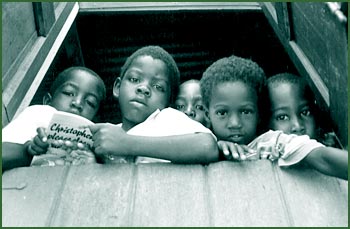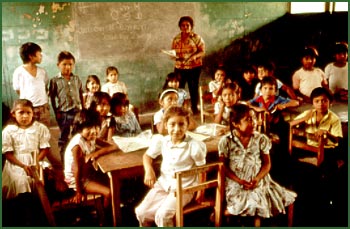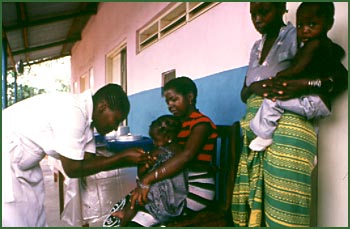Escaping the Debt Trap
by Murray MacAdam

The Third World is on the hook for over two trillion dollars, and millions of people are paying the price. Many developing countries spend more on debt payments than on education and health combined. So an international citizen's campaign is calling for relief. |
It's like a hangover that drags on far past New Year's. Your January credit card statement arrives with all those Christmas gifts on it. You open the envelope. Ouch...look at all that interest.
You resolve to buckle down and pay off your debts. But the next day at work, the boss delivers bad news. Due to declining sales, he is cutting your wage by 20 percent.
OK, so you'll try to pay off your credit card next month. But when that dreaded Visa bill arrives, you're shocked to discover the interest rate has doubled. Panic sets in. You and your family have to slash spending big-time. You've got to cut way back to meet those whopping credit card charges.
Tough times are staring you in the face.
Not a pleasant scenario, right? Now imagine it involving not just you and your family, but your entire country. And not a rich country like Canada. Rather, a country that has watched the prices of its main exports plunge year after year, making it all but impossible to meet its debt obligations.
That's the prospect faced by dozens of nations trapped in the Third World debt cycle, in hock to foreign banks, governments and multilateral bodies such as the International Monetary Fund (IMF).
And hundreds of millions of people are paying the price. Many developing countries spend more on debt payments than on education and health combined.
But unlike you or I, these countries cannot declare bankruptcy, wipe the slate clean and start again. They have to pay these "preferred creditors" in full and on time.
In the 42 most 'Heavily Indebted Poor Countries' as defined by the World Bank Group, 600 million people struggle to survive on less than a dollar a day. Yet these same countries send the world's rich countries $64 million every day to cover the interest and capital payments on their total $213 billion debt (all figures U.S. dollars).
How these countries sunk so deep in debt is a complicated tale too long to fully tell here. In short, billions of dollars - much of it money from oil earnings in the Middle East recycled through Western banks - were lent to Third World nations decades ago to help them 'develop.'
Tragically, relatively little of this borrowed money went to uplift people from long-term poverty. Too much was spent on military arms, wasted on disastrous mega-projects, squandered by corrupt dictators or siphoned off to rich elites.
High interest rates in the 1970s and 80s made matters worse, and low commodity prices for traditional Third World exports such as coffee, sugar and tin left poor countries broke, without the foreign exchange necessary to pay their debts.
Money that should have been earmarked for projects to reduce poverty was sent back to developed nations to service old debt principle and interest. Unable to fully pay off or default on previous loans, developing countries had to, and still do, take out new loans to keep afloat.
And so the debt spiral deepens.
As a condition of new loans from bodies such as the IMF, governments usually have to implement harsh free market measures known as 'structural adjustment policies' (SAPs). SAPs generally call for deep cuts to social programs and government services, the selling off of state enterprises and the promotion of raw resource exports over local food production.
On paper, the plan is to help get economies back 'on course' and trim bloated and inefficient bureaucracies.
But in reality, the controversial policies often result in deepening poverty and social unrest.
You need look no further than recent headlines to see the repercussions of the debt crisis. In Argentina riots, strikes, demonstrations and the collapse of the government followed deep slashes to public spending to satisfy international creditors. In December 2001, the IMF held back $1.3 billion, after Argentina failed to meet budget deficit targets.
Argentina is saddled with a $132 million foreign debt. While much of the media coverage was focused on Argentina's exchange rate system and other economic policies, "missing from the discussion is the glaring failure of the international financial system, which has been increasingly prone to such debt crises," notes Roy Culpeper, president of the North-South Institute.
And Argentineans aren't alone.
Total long-term debt of the137 developing countries reporting to the World Bank reached $2,071 billion in 1999 - over four and a half times greater than in 1980. The money is owed to commercial banks and other private lenders, directly to the governments of First World countries, and to international financial institutions such as the World Bank and IMF - what is known as multilateral debt.
These debts have literally trapped billions of people around the world. We don't expect Canadians who go bankrupt to sacrifice their children's health and education so they can keep paying their debts. Yet millions of children in the Third World die each year of poverty-related causes, because their governments must make payments to rich countries and other creditors.
And in the push to generate fast cash to pay off the debts, the environment is pushed beyond sustainable limits. Deforestation and desertification are all too common sights in much of the Third World.

To put a face to the crisis, let's look at Tanzania as an example. Debt payments devour 35 percent of that African nation's national budget. The government spends nine times as much on debt repayment as on basic health care and four times as much as on primary education.
An Oxfam report released in 1998 called Failing the World's Children found that "...per capita spending per pupil has fallen by one third since 1990. In 1997, as debt payments rose, the budget for school materials was cut by almost 20 percent."
Enrolment of primary school-aged kids has fallen from 96 percent to less than 75 percent since the government followed the IMF's structural adjustment orders in 1993. Two and a half million million children are out of school in Tanzania.
As the late Julius Nyerere, former president of Tanzania once asked, "Is human development a possibility when so much of Africa's wealth is channelled into debt servicing?"
Meanwhile, prices have plunged for Tanzania's major exports - coffee, tea, cotton and sisal (the leaves of the agave sisalana plant can be made into rope and various textiles). Interest rates have soared, multiplying the amount to be repaid. And a 1500 percent devaluation in the Tanzanian currency has increased the amount of international or 'hard' currency needed to repay.

Trish Wind, a Canadian development worker in Tanzania, sees the impact of the debt crisis on people's lives each day. Kurasini Primary School, near her home in Dar es Salaam, is jammed with 6,000 students - but has only 18 classrooms. 150 kids are jammed into each classroom, with only one textbook for every 4-6 kids.
It's not exactly the best of learning environments.
"As our next-door neighbour told us, 'sending your kids to the government schools just destroys their minds,'" says Wind.
This is a debt to all our futures, because as the cliché goes, we live in an inter-dependent world. A healthy Third World is important to the well being of us all.
Some would argue that the money simply has to be paid back. If you borrow it, you are on the hook for it, end of story. But Third World countries would not be getting a "free ride" if their debts were cancelled. They've been repaid many times over.
The never-ending hole that we think we throw our foreign aid money into actually flows upwards.
Between 1981 and 1997 the less developed countries paid over $2.9 trillion in interest and principal payments. That's about $1.5 trillion more than what they received in new loans.
For every dollar of 'official development assistance' Third World countries received in 1999, they paid out almost six dollars in debt payments.
Over the years, there have been attempts to 'tinker' with multilateral debt through rescheduling payments and reducing interest rates. But the best hope recently came from something called the 'Highly Indebted Poor Country (HIPC) Initiative.' It promised debt relief for 41 low-income countries when the World Bank and IMF launched it in 1996.
An expanded HIPC Initiative emerged from the 1999 G8 Summit in Koln, Germany, promising an additional $50 billion worth of debt relief for the 33 countries expected to qualify.
By the end of 2001, 24 countries had qualified for $36 billion in debt relief, provided they continue to apply Structural Adjustment Programs monitored by the IMF and World Bank. The Bank and IMF say these countries will see their debts reduced by almost half.
Additional write-offs of bilateral debts through the Paris Club (an informal group of creditor countries who co-ordinate strategies for dealing with the money owed to them by debtor nations) could lead to average debt reductions of about two-thirds.
It sounds promising. However, of these first countries to receive debt relief, over half will still spend more on debt than on primary education, and two-thirds will spend more servicing their debt than on health care.
The enhanced HIPC plan is basically a creditors' plan to help the World Bank and IMF write down debts that are uncollectible in any event. For example, the World Bank and IMF lauds debt relief for Nicaragua, saying the debt will be cut from $6.3 billion to $1.8 billion.
But Nicaragua has been able to pay only about half the debt interest it owes anyway, especially in the wake of the devastation caused by Hurricane Mitch external link to in 1998. Paying back the loan in full is a virtual impossibility.
Similarly, Tanzania qualified last November for $2 billion in debt relief. Its debt will be cut by an average of 47 percent, from $193 million before HIPC in 1999/00, to an average of $116 million from 2001 to 2010/2011. Yet actual debt payments - which include the interest - will dip only slightly.
And things grew worse for Tanzania last year, when prices for coffee and cotton - its key exports - plunged. So the current payment schedule is still a heavy burden.
Other countries share Tanzania's plight. On average, the debt relief agreed to so far provides an average 30 percent cut in repayments for the countries involved. Development workers are warning that it's not fast enough or deep enough to make a real difference on the ground for deeply impoverished countries.
The head of the Organization of African Unity agrees. "Although commendable initiatives have been taken for the alleviation and cancellation of the debt of some African countries, the international community in general has turned a deaf ear to the appeals of the continent," says Amara Essy.
The real hope may come from an international citizen's campaign that has mobilized millions of people around the world to call for debt cancellation. Based on biblical "Jubilee" laws on debt relief, the campaign was originally started by British church leaders who said, in essence, 'for the love of god give the Third World some relief.'
Jubilee 2000 became an international campaign calling for the cancellation of the unpayable debts of the most impoverished nations of our world.
Now called Jubilee +, it was created by Christians inspired by traditions of debt relief and release from slavery every 50 years, as recorded in the bible. ("You shall hallow the fiftieth year and proclaim liberation in the land for all its inhabitants. You shall make this your year of Jubilee." - Leviticus 25:10).
By the late 1990s, pop star Bono of the rock band U2, the Pope, activists and people of different faiths had signed on, pushing North American and European governments to forgive the debts of the poorest countries.
United Nations Secretary General Kofi Annan also joined the cause, asking "...donor countries and the international financial institutions to consider wiping off their books all official debts of the heavily indebted poor countries in return for those countries making demonstrable commitments to poverty reduction."

Jubilee campaigns rose up in many countries in addition to Great Britain, including the U.S. and Canada. Thanks to the Canadian Ecumenical Jubilee Initiative, 640,000 Canadians signed the debt relief petition - the most successful church-backed Canadian petition drive ever.
And in the South, Peru's 1.8 million signatures made it the country with the most per capita involvement in the international Jubilee campaign.
By the end of 2000, the worldwide Jubilee campaign had garnered an amazing 24 million signatures calling for outright cancellation of unpayable debt.
Jubilee + is now pushing for the outright cancellation of developing countries' illegitimate debts, without adherence to strict Structural Adjustment Programs. This includes:
- Immediate 100 percent cancellation of the debts owned by low-income countries on the grounds that they are illegitimate, since repayment violates the human rights of countries' citizens.
- Assessing the debts of all developing nations, leading to cancellation of those incurred illegitimately.
What is an illegitimate debt? $13 billion is owed by the Democratic Republic of Congo (formerly Zaire), even though much of it was lent to former dictator Mobutu.
And in Argentina, billions of dollars of private debt were effectively nationalized and incorporated as public debt during Argentina's military regime (1976-83).
The Jubilee coalition estimates that nearly $500 billion - nearly one quarter of all Third World debt - is from loans to dictators in 25 countries.
This grassroots pressure has led to action. The IMF, World Bank and leading creditor nations have been forced to offer some debt relief to some of the poorest countries. By the end of 2000, rich countries had promised to write off $110 billion in debt. As well, some countries have chosen to forgive or suspend debts owed to them. Britain pledged to either stop collecting, or to hold in trust, all debt payments to it from 41 of the world's poorest countries.
Canada's Finance Minister Paul Martin has also shown leadership on the debt issue. At World Bank and IMF meetings in September 2000, he called for a moratorium on the collection of bilateral debt, and criticized the tough conditions attached to debt relief.
Three months later, he announced a moratorium on debt repayments to Canada by eligible Heavily Indebted Poor Countries. Canada is currently owed about $1.1 billion by seventeen HIPCs. Eleven, with $700 million in total debt, will benefit from Ottawa's plan: Benin, Bolivia, Cameroon, Ethiopia, Ghana, Guyana, Madagascar, Senegal, Tanzania and Zambia.
Six other countries, Congo, Ivory Coast, the Democratic Republic of Congo, Liberia, Rwanda and Sudan, which together owe Canada an additional $370 million, can also join this debt-relief club once their human-rights and 'good governance' records improve.
"The current debt levels carried by the world's poorest countries are quite simply unsustainable," says Finance Minister Paul Martin. "A debt moratorium will free up resources that indebted countries could spend on urgent social priorities such as health care, education and poverty reduction."
Many debt activists welcomed the announcement. But as John Dillon of the Jubilee Initiative of Canada said, "Unfortunately, it's a drop in the bucket. Money owed to Canada is less than one half of one percent of impoverished countries' total debt."
While the Canadian Ecumenical Jubilee Initiative has wrapped up its work, Canadian action around debt continues through the church-backed KAIROS coalition, a group of Canadian churches, church-based agencies and religious organizations dedicated to promoting human rights, justice and peace.
"We're moving forward on a couple of fronts, including the illegitimate debt and the inadequacy of the HIPC Initiative," says KAIROS staffer John Mihevc. "The whole effort is stalled and the amount of debt relief offered is inadequate."
One creative idea is for an International Insolvency Court, as proposed by the U.N. Conference on Trade and Development (UNCTAD) and many NGOs (non-governmental organizations). Similar to bankruptcy laws that allow companies to remain solvent during cash crunches, it would allow cash-strapped countries to suspend debt payments legally and without penalty. Debtor nations could then renegotiate loans.
The IMF is considering such a measure for countries facing unsustainable debt burdens. New IMF-supervised ground rules would be put in place, under which debts and creditors would have to work out compromises, with concessions on both sides.
"It would make crisis management more orderly and less costly, by forcing countries to face up to their problems promptly," said IMF official Anne Krueger.
But having the IMF supervise such an arrangement would still leave too much power in the hands of creditors, says Roy Culpeper of the North-South Institute. He believes we need an international bankruptcy mechanism that would require other measures to prevent future crises. On its own, the IMF plan "puts far too much faith in the self-regulating capabilities of the global capital market."
It also assumes equal power between debtor countries and their creditors, something only true for larger indebted nations. "Most other debtors will have a hard time getting a fair deal," maintains Culpeper.
Debt swaps have also been proposed. UNICEF brokered an innovative deal with international banks where some of the money owed to poor countries was not paid to the banks, but instead went to UNICEF.
The banks received tax deductions, and UNICEF collected the debt repayments in local currency (not foreign currency) and spent this money for programs to help children.
Substantial debt relief, combined with other development measures, does work, as Uganda's progress shows. After going through the G8's international debt cancellation process, the African nation's annual debt repayments have been halved.
The government then met with NGOs, churches, poverty activists and others to create a Poverty Eradication Action Plan to use money freed up from debt relief to improve its education system, health care and basic infrastructure.
Providing free primary education emerged as the priority. The result? Enrolments in primary schools jumped from 2.5 million kids in 1997 to 6.5 million in 2000. A grassroots network called the Uganda Debt Network is keeping up the pressure to make sure debt relief leads to strong anti-poverty measures.
Of course, forgiving a country's debt won't solve all its problems. But as Tanzania-based development worker Trish Wind says, "Debt relief combined with democratic reforms and monitoring by citizens groups to ensure the government channels savings to poverty, is needed to provide justice for millions of people."
"Without this, the work of NGOs is simply overwhelmed."
The debt crisis might seem overwhelming. Yet a huge breakthrough has already occurred. Millions of people around the world have acted on an issue that had previously been the domain of an elite group of bankers and politicians.
Says Ann Pettifor of Britain's Jubilee campaign, "When we began, there was widespread scepticism that we could educate a mass [population] on the complexities of debt, and doubt that we could alert people to the way in which poor countries are forced to divert precious scarce resources from clean water, health and sanitation, and into debt repayment to rich creditors."
"Many policy experts declared the Jubilee 2000 project impossible. But they were wrong. Jubilee had confidence in people, believing that they can understand and grapple with supposedly complex financial matters. This empowerment of millions of people is one of the campaign's greatest achievements."
"The world will never be the same."
Murray MacAdam is a Toronto-based writer specialising in community development and global issues.
Written February 2002
| Return to Top
|
| Articles Archive
| About Our Times |